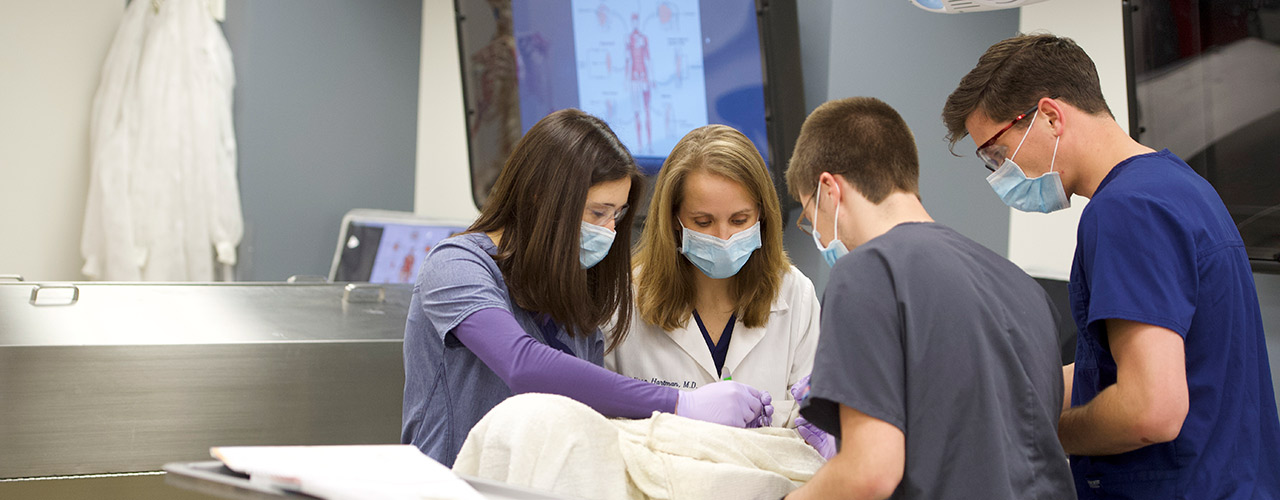by Bryson Durst
The tools available to our health sciences students are just one example of the way Cedarville invests in cutting-edge resources for all academic disciplines. From the cadaver lab in health sciences to the Torah scroll in biblical studies and the Trading Room in the School of Business, top-tier educational assets are equipping Cedarville students for career job placements and high-profile postgraduate opportunities.
At Cedarville, our health sciences programs are preparing the next generation of outstanding nurses and nurse practitioners, skilled athletic trainers, and pending final professional accreditation, insightful and caring PAs. Our leading-edge technology will help ensure they can make a life-changing difference in the U.S. and around the world. These remarkable resources include:
- A Gross Anatomy Lab that reinforces what undergraduate science and allied health majors learn in the classroom, helping them better understand relationships between body systems and giving them a head start for graduate school.
- A digital anatomy device called the Anatomage Table to help students in Cedarville’s new Master of Athletic Training program interact with and learn about the structures of the human body in a virtual, interactive, and reversible manner.
- A recently upgraded, state-of-the-art Simulation Center to ensure nursing students continue to gain invaluable experience in a wide range of real-life patient care situations.
EXTRAORDINARY EXPERIENCE: THE GROSS ANATOMY LAB
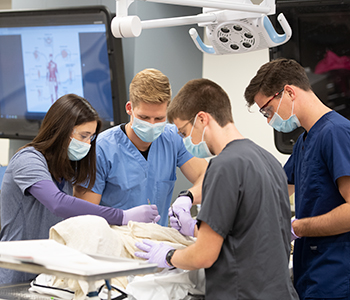 There are some classroom concepts that textbooks cannot fully do justice to, such as the human body. As part of Cedarville’s commitment to excellence, the University’s Gross Anatomy Lab gives undergraduate students hands-on experience as they learn about the human body.
There are some classroom concepts that textbooks cannot fully do justice to, such as the human body. As part of Cedarville’s commitment to excellence, the University’s Gross Anatomy Lab gives undergraduate students hands-on experience as they learn about the human body.
The lab features four cadavers, with two new ones received every semester from the Wright State University Boonshoft School of Medicine Anatomical Gift Program (Fairborn, Ohio). Each semester, eight students who have earned high marks in an upper-level anatomy course can participate in the human dissection course (a biology elective).
During that semester, students work alongside the anatomy professor learning dissection technique and proper care of the cadaver. They gain more than 40 hours of hands‑on dissection experience on a newly donated cadaver (4:1 student-to-cadaver ratio). This is a valuable experience, especially for students who will be entering medical, dental, or physician assistant (PA) school the following year. Additionally, the cadavers dissected the previous semester are used in each of the other undergraduate anatomy courses offered at the University.
“We’ve had a number of alumni say that they felt their experience in the dissection lab gave them an advantage going into medical school since Gross Anatomy is often the first course encountered in medical school,” said Melissa (Hartman) Burns ’96, Assistant Professor of Biology.
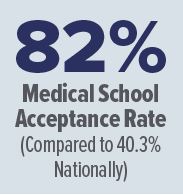 “Many of their grad school classmates have little or no exposure to human cadavers,” she added. “I believe having a Gross Anatomy Lab at the undergraduate level is a unique and valuable learning tool, especially for students pursuing careers in healthcare.”
“Many of their grad school classmates have little or no exposure to human cadavers,” she added. “I believe having a Gross Anatomy Lab at the undergraduate level is a unique and valuable learning tool, especially for students pursuing careers in healthcare.”
The dissection lab also reinforces the learning experience for students in the other anatomy classes.
“To see the actual organs and muscles, to be able to touch them, to pick them up and hold them, provides a hands-on interaction in a way that can’t be replicated by reading a textbook,” said Burns. “But once you’ve had that hands-on interaction, you can go to a textbook or an anatomy atlas, and it will make a lot more sense.”
That experience has helped Cedarville premed alumni who are now in medical schools across the country. According to Burns, over the past five-year period (2017–2021), 82% of Cedarville premed students who applied to medical school were accepted (58 of 71), and over that same time, 63% (45 of 71) were accepted as first-time applicants. Based on statistics from the American Association of Medical Colleges, 40.3 percent of applicants were accepted to medical nationwide during the same five-year period.
HIGH-TECH STUDY: THE ANATOMAGE TABLE
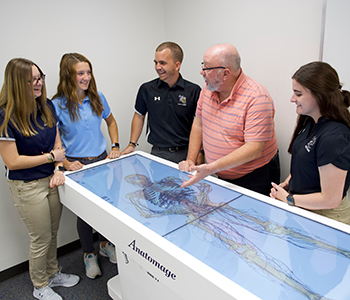 Complementing the cadaver lab, Cedarville’s School of Allied Health recently invested in an interactive digital anatomy device called the Anatomage Table. Using two giant touch screens, students in the Master of Athletic Training program will analyze detailed scans of four people who gave permission for their bodies to be used before they passed. They will also be able to review case studies to determine the underlying disease processes of these patients.
Complementing the cadaver lab, Cedarville’s School of Allied Health recently invested in an interactive digital anatomy device called the Anatomage Table. Using two giant touch screens, students in the Master of Athletic Training program will analyze detailed scans of four people who gave permission for their bodies to be used before they passed. They will also be able to review case studies to determine the underlying disease processes of these patients.
The table will allow students to move and rotate bodies, adding and removing layers to see the skin, muscle, bones, blood vessels, and internal organs. Faculty members will be able to integrate the table into quizzes and lectures, asking students to identify various body structures.
The Master of Athletic Training program will also use traditional cadavers when it launches this summer, but unlike cadavers, students will be able to use the Anatomage Table outside of class on their own. The table will also allow students to instantly analyze structures that would be difficult to access in a traditional cadaver.
And while students cannot put cadavers back together when they have finished dissecting, they can add and remove layers of the human body on the Anatomage Table at will.
“The Anatomage Table will enhance what we will be using in cadaveric studies,” said Mike Weller, Associate Professor of Athletic Training and the program’s director. “It might better suit the learning style of someone who has grown up with this type of technology.”
Cedarville is one of only a few universities in Ohio with an Anatomage Table. It will be exclusive to the Master of Athletic Training program for now, though Weller envisions opening it up to other programs in the School of Allied Health.
REALISTIC PRACTICE: NURSING SIMULATORS
Understanding course concepts is important, but practice is a crucial component of the learning experience. Cedarville provides students with opportunities to practice through a Simulation Center, which the Schools of Nursing, Allied Health, and Pharmacy recently updated to ensure a state-of-the-art experience for years to come.
The latest update is the SimCapture Pro, a cloud-based simulation management platform with multi-angle video recording, simulator data capture, annotation, streaming, and debriefing capabilities, as well as self-reflection for simulation participants.
Junior and senior nursing students use lifelike mannequins in the center’s three high-fidelity bays, two with Laerdal SimMen mannequins and one with a Laerdal SimMom, to practice their reasoning and judgment skills.
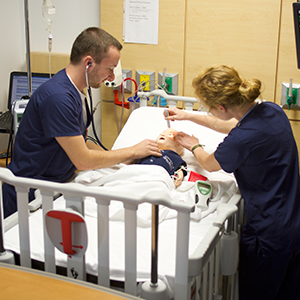 These simulators can sweat, bleed, and produce heart sounds, lung sounds, and vital signs such as heart rate and oxygen saturation. Students use the SimMen to assess these indicators and provide necessary medication and care. They use the SimMom to practice labor and delivery care, along with moderate-fidelity infant and child simulators for pediatric scenarios.
These simulators can sweat, bleed, and produce heart sounds, lung sounds, and vital signs such as heart rate and oxygen saturation. Students use the SimMen to assess these indicators and provide necessary medication and care. They use the SimMom to practice labor and delivery care, along with moderate-fidelity infant and child simulators for pediatric scenarios.
Upperclassmen nursing students spend two four-hour shifts with high-fidelity simulators each semester. They use these simulators for medical-surgical, mental health, maternity, and pediatric clinical courses, as well as complex care and leadership courses specifically for seniors.
Nursing and pharmacy senior students also jointly participate in a weeklong Advanced Cardiac Life Support (ACLS) mock code certification opportunity at the start of the spring semester.
Karen (Mathews) Callan ’85, Coordinator of the Nursing Labs and Facilities, runs the high-fidelity simulators along with other faculty members who ensure a realistic simulation experience.
“In the Simulation Center, students apply their knowledge, skills, and, most importantly, their clinical judgment, clinical reasoning, and effective communication skills,” said Callan.
In other skill labs within the School of Nursing, sophomore nursing students interact with moderate-fidelity simulators in guided simulations where they learn the basics of vital signs and what they indicate.
These simulations do not replace clinicals in a real hospital, but they add to the learning experience. By simulating a hospital environment without the possibility of real-world consequences, students can take the lead tackling complex medical issues. Debriefings allow students to analyze what they did right and wrong. Students who role-play loved ones also give nurses practice communicating with a patient’s friends and family and dealing with end-of-life issues.
“It’s very realistic, and it gives students the opportunity to actually feel like they are in a clinical setting,” said Callan. “They get to be the nurse making real decisions based on their assessments. The practice of communicating to other professionals that are role-played by faculty during scenarios has given our graduates excellent practice in organizing and articulating important information to other healthcare professionals.”
With such a training environment, is it any wonder that Cedarville nursing students, and health science majors in general, are sought out by employers around the country. Excellent technology guided by excellent faculty leads to excellent results.
…..
Bryson Durst ’22 is a communication major at Cedarville University and a Public Relations student-writer.

















